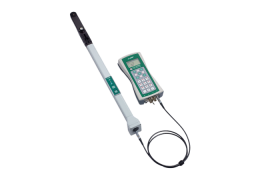This section is for those who want to know more about the nuances of indirect LAI measurements.
Wand Calibrations
It is helpful to understand what is meant by an LAI wand calibration. Each wand receives two types of calibration at the factory. One is an angular calibration, which ensures that each ring has the proper angular response to light. This calibration is actually done a few times, with physical adjustments to the optics performed in response to each, until the response meets our criteria. This calibration should be stable for the life of the wand, and it would likely take physical damage to the wand to change it.
The other calibration that is done involves placing the wand into an integrating sphere (an isotropic environment), and results in the five ring multipliers that are stored in the wand's software. When these multipliers are applied, the wand can be used to make valid distribution measurements of brightness, in which the output of each ring can be compared to the others. That is, under a perfectly uniform sky, all rings would read the same value. For basic LAI measurements, this calibration is not important, since each ring is ratioed with itself, so its absolute value doesn't matter. When doing scattering corrections, measurements of sky brightness distribution are required, and thus, this calibration comes into play.
What the ring factors do not do is ensure that two sensors will read the same under the same conditions. The relative distributions (one ring to the next) will be right, but the absolute values may well be different. This is why sensor matching is important.
General Considerations When Matching Sensors
The following items will affect how two sensors compare:
Size and Orientation of View Cap
The size of the view cap has a primary effect on what the wand reads. Less obvious, however, is the fact that the detector rings in the sensor typically have some small azimuthal variation in sensitivity, so how the view cap is oriented also has an effect. Therefore, when matching sensors, use the view cap that will be used for the measurements, and in the orientation (relative to the wand handle) that will be used for measurements.
Dirt/Dust on the Lens
If you keep the lenses clean while collecting data, then match information that is also obtained under clean lens conditions will still be valid. Otherwise, you can get match data before and after a series of measurements to verify it hasn't changed, or to interpolate match data through the time period. (This can't be done with console matching, but can be done with FV2200 matching)
Sky Conditions
Theoretically, two perfectly leveled sensors with the same view cap aimed in exactly the same direction will see the same sky. As a practical matter, they may not be perfectly leveled nor aimed in exactly the same direction, nor have the exact same angular response. Therefore, the best sky to use when matching sensors is one that is as uniform as possible, which means blue sky with no clouds. The worst case is blue sky with some scattered clouds. If the portion of sky being viewed has a bright cloud not fully contained within a ring's view, then slight variations in view (direction or level) could make a significant difference, because the sensors will see differing amounts of that sunlit cloud, and that cloud is many times brighter than the blue sky around it. Matching sensors that are viewing clouds will build in some biases to your measurements, so avoid it.
Detector Age
As a wand detector ages, its absolute calibration is subject to slight drift. If you match sensors even once a season, this should not be an issue.
Temperature
Temperature represents a potential cause of drift in how sensors compare. Again, matching sensors once a season will likely take care of this as well.
Some Scattering Correction Details
Scattering of light by foliage is greatest when the sun is behind the viewer. It is at a minimum when the sun is in front of the viewer. The simple reason for this is that the view with the sun at your back is dominated by foliage reflectance (say 0.05 for leaves, stems, and branches), while the view toward the sun is dominated by foliage transmittance (say 0.01 for leaves, and 0 for stems and branches).
You cannot make LAI measurements with the sensor oriented toward the sun, of course, but if your measurements are near the sun (keeping it blocked by the view cap), then the scattering error in the uncorrected readings could be much less than if the sensor is looking directly away from the sun’s direction.
The scattering correction implemented in FV2200 takes orientation into consideration. The measurement direction and view cap information is part of the “hand entered” information specified when generating K records. Solar position (azimuth and zenith) is computed from UTC and your latitude and longitude. If the console is equipped with GPS, and G records were included in the file, then latitude, longitude, and UTC are known. Otherwise, you specify latitude and longitude of the measurement site, and its time zone (or more specifically, the hour shift between the console clock and UTC).
Rain, Fog, and Dew
Accurate measurements can be made in wet canopies if care is taken to keep water droplets off the lens. Working in rain is also possible, but measurements will have greater uncertainty. Droplets on the lens present a concern because they block light. A few small droplets can reduce the light seen by some rings by 10% or more. Therefore, it is important to keep the lens free of droplets by wiping it with the cloth provided in the lens cleaning kit.
